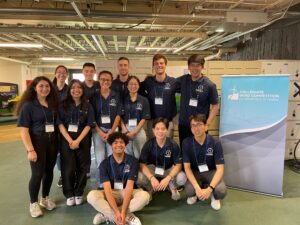For the third straight year, the Johns Hopkins Student Wind Energy Team (HSWET) had a great showing at the Collegiate Wind Competition (CWC), which is hosted by the U.S. Department of Energy (DOE).

HSWET representatives at the 2023 CWC
HSWET, which is mentored by Dennice Gayme, a core faculty member of the Ralph O’Connor Sustainable Energy Institute (ROSEI) and Rui Ni, a ROSEI affiliated faculty member, placed first in the CWC’s Turbine Design subcategory. One of four smaller competitions that combine to create a team’s final score at the CWC, the Turbine Design entailed designing, building, and presenting a unique, wind-driven power system based on market research and testing the wind turbine in an on-site wind tunnel.
“Our team was able to succeed because we had dedicated sub-team leads with a great group of team members who put in the time and effort to see the project through,” said Kathy Cao ‘23, the HSWET vice president for this year who also just graduated from the Department of Mechanical Engineering (MechE). “All of our sub-team leads have been involved in the team for two years or more, so we knew each other and the project really well.”
HSWET had four different sub-teams working in this subcategory:
- Aerodynamics, led by Justin Lee ’23 (MechE)
- Generator, led by Evan LaTourrette-Ghez ’23 (MechE) and David Corrente ’24 (MechE)
- Electronics and Controls, led by Eleni Daskopoulou ’24 (Department of Electrical and Computer Engineering) and Isaac Lee ’23 (MechE)
- Structures, led by Cao
The group had sub-team meetings every week where they worked on individual components, and then also came together twice a week for sub-team lead meetings to talk about how to integrate the different parts together and test them.
Though HSWET was judged on the power production and durability of its wind turbine, the technical design was judged based on several short reports submitted throughout the year. When it came to the turbine’s design, there were rules that constrained its size and controls, however, the parameters also left a lot of room for creativity when it came to design choices, which the team embraced.
“A new part of the design contest this year was the ‘control of rated power and rotor speed’ task. This meant that above a certain wind speed, we had to keep power output and rotational speed constant,” LaTourrette-Ghez said. “To do this, we used sensors to measure the wind speed and turbine rotational speed, and actively controlled our blade pitch angle. This allowed us to capture the appropriate amount of power from the changing wind.”
For the Structures sub-team, a lot of time was spent considering the weight of the foundation and how it would impact the effectiveness of the turbine.
“The goal was to make the lightest foundation that could withstand the highest wind speeds since points were awarded for both relative weight and foundation performance,” Cao said. “It was a valuable experience to hear feedback from judges who were working professionals from the wind industry, and it was also very rewarding to hear them commend our design.”
Now that they have graduated, both Cao and LaTourrette-Ghez hope to enter the renewable or sustainable energy industry and believe that being a member of HSWET has helped prepare them for that transition. With a decent chunk of the team recently graduating, there will be plenty of spots available on next year’s team for students from a variety of backgrounds who also want to go down that career path.
“HSWET accepts all students interested in learning more about wind energy regardless of grade or major. Our goal as a club is to offer opportunities for students to interact with their peers and industry professionals to gain experience and knowledge of wind energy,” Cao said. “In addition to the engineering team, HSWET also includes a project development team that makes a hypothetical wind farm siting and finance plan and an outreach team that plans wind energy focused events on and off campus. The team is always looking for students that are passionate about sustainability or renewable energy to join.”
Click here for the full results from the 2023 CWC.

